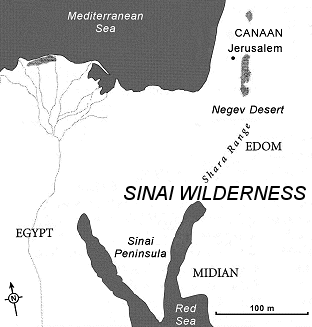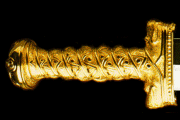The Mountain of God
Moses striking the rock, as depicted by the seventeenth-century Italian painter Valerio Castello.
The Bible tells how Moses created a miraculous spring at Mount Sinai by striking his staff against a rock. This was the vital clue that enabled Graham to locate the forgotten Mountain of God.
The Bible tells how Moses created a miraculous spring at Mount Sinai by striking his staff against a rock. This was the vital clue that enabled Graham to locate the forgotten Mountain of God.

Since Roman times, the Church has identified Mount Sinai as Jebel Musa in eastern Egypt – the site that tourists and pilgrims still visit today. This tradition originated with a vision said to have been experienced by Helena, the mother of the first Christian Roman Emperor, Constantine the Great, around 325 AD. Nevertheless, there is no actual biblical or archaeological evidence to support it. Despite Constantine naming the site as Mount Sinai, the geography of the area does not tally with the Old Testament descriptions. Modern biblical scholars have fiercely debated Mount Sinai’s true location, and to this day it remains one of the Bible’s most contested mysteries. If we examine the Old Testament carefully, however, it does provide important clues to reveal another location for the Mountain of God that seems to have been completely overlooked.
Jebel Musa

The summit of Jebel Musa in eastern Egypt. Since Roman times, Jebel Musa has also been called Mount Sinai. There is, however, no biblical, archaeological, or historical evidence that this was ever the ancient Israelites’ Mountain of God.
The Backside of the Desert
According to Exodus 2:15-21, after he was forced into exile from Egypt, Moses settled in the land of Midian where he married the daughter of a local priest. Some years later, Moses was tending his father-in-law’s flock when he was confronted by a bush that burned without being consumed. It was from within this miraculous fire that Moses first heard the voice of God. According to Exodus 3:1, this event took place at Horeb, another name the Bible uses for the Mountain of God:

Now Moses kept the flock of Jethro his father-in-law, the priest of Midian: and he led the flock to the backside of the desert, and came to the mountain of God, even to Horeb.
Midian was the ancient name for the area to the immediate east of the Gulf of Aqaba, in what is now the extreme northwest of Saudi Arabia. Just like today’s Bedouin, the peoples of Midian were nomadic shepherds; entire family groups would lead their flocks of sheep and goats hundreds of miles in the course of a year around the Sinai Wilderness to the north of Midian, continually moving on to fresh grazing land. This, it seems, is what Moses was doing when he encountered the burning bush. If the desert in the above verse was the Sinai Wilderness, then the words “backside of the desert” - where the Mountain of God was from the perspective of Midian - must have referred to the extreme north of the region. This would be somewhere in what is now the Negev Desert, in southern Jordan, a land that in biblical times was called Edom.
Moses and the Burning Bush by the Italian artist Domenico Feti (1613). According to the Old Testament, Moses first discovered Mount Sinai when the voice of God spoke to him there from
the midst of a burning bush.
In the early second millennium BC, the Hebrews, originally from what is now northern Iraq, migrated south into the Sinai Wilderness where they became a nomadic people. According to the Bible, God first revealed the whereabouts of Mount Sinai to one of these nomads, the prophet Abraham, around five centuries before the time of Moses. In the biblical account, two separate groups of Hebrews descended from Abraham’s grandsons, Jacob and Esau. Jacob’s line, the Israelites, settled in Canaan, while Esau’s line, the Edomites, established their kingdom of Edom around the Shara mountain range in the north-eastern Sinai Wilderness. It would seem, going by the burning bush account, that it was somewhere in this land of Edom that Mount Sinai was to be found.
The Land of Edom

The kingdom of Edom was located in the was backside of the desert from the perspective of Midian, in the far south of the Sinai Wilderness. It lay in the shadow of the Shara Range. Was one of these mountains the biblical Mountain of God?
The kingdom of Edom was situated in and around the Shara Mountains which are today a part of southern Jordan. If Graham’s reasoning was correct, then Mount Sinai must have been one of the mountains in this range. The problem facing him was that there are dozens of mountains in the Shara Range. Which of them was the Mountain of God?
The Miraculous Spring

Moses and the miraculous spring, as depicted by the Victorian English painter Edward Poynter. Two Old Testament accounts of what seem to be this same event, when taken together, reveal the precise location of Mount Sinai.
The Israelites’ time in wilderness after they escaped Egypt is described in four separate accounts in the Bible. These are found in the Old Testament books of Exodus, Leviticus, Numbers, and Deuteronomy. In the Exodus account, when the Israelites first arrive at Mount Sinai, Moses strikes his staff against a rock at the foot of the mountain to create a miraculous spring. A story of Moses creating another miraculous spring is recounted in the book of Numbers. Could these actually be referring to the same event? If so, then taken together, they revealed the precise location of Mount Sinai.
There was another biblical clue that seems to have been completely overlooked by previous researchers who attempted to locate Mount Sinai - the story of Moses’ miraculous spring.
The Israelites were enslaved by the Egyptians and, according to the Bible, came to forget God; the Edomites, however, remained free. Although the Bible portrays Moses as discovering God on Mount Sinai when He spoke to him from a burning bush, the history behind the story might be that Moses rediscovered the religion of his ancestors from the Edomites who were still venerating the Hebrew God at the holy mountain.
The Exodus account has the incident occurring at Horeb, another name for Mount Sinai, without revealing where the mountain is (Exodus 17:5-6). The Numbers account, on the other hand, although not referring to Mount Sinai, does provide an identifiable location for the event: a place called Kadesh, which is said to have been the entrance to the kingdom of Edom (Numbers 20:9-17). Although the Edomites had settled an area to the east of the Shara Mountains, archaeology has shown that the heart of their kingdom was actually within the range. It was situated in an easily defended valley, known as the Valley of Edom, the only way into which, avoiding the grueling haul over the mountains, was through a narrow rocky gorge today known as the Siq. This has to have been the entrance to the Edomite kingdom referred to in the Numbers account. The Siq cuts between two mountains. Was one of these the real Mountain of God?
Page 2 of 4








